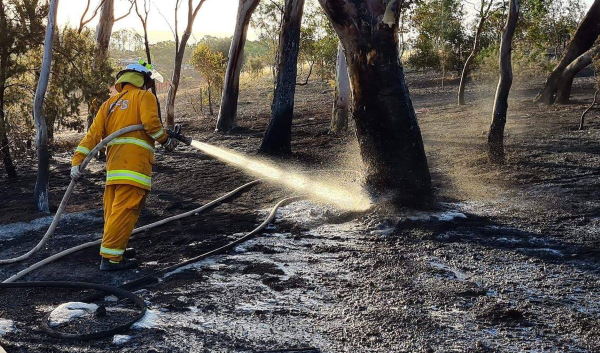
This work is licensed under a Creative Commons Attribution-ShareAlike 4.0 International License

Firefighting Foam
Makes water stick

The purpose of using A Class foam in firefighting, is to provide a surfactant to the water, which assists the water to penetrate the material to provide cooling, and to lessen the effect of run off from the material. There are three types of foam used commonly in today's firefighting, and these are:-
- A class foam, for wood and paper type materials,
- B class foam, for flammable liquids, and
- ATC foam for alcohol, polar solvents, and water insoluble hydrocarbon flammable liquids.
A Class
The type of foam used at an incident, such as a scrub or grass fire is generally the A class foam, at an application rate of 0.1% foam to water mix. This will enable the water to penetrate the grass and wood involved, and provide cooling of the material. The same foam is used in structure firefighting, enabling better penetration of water into burning materials.
B Class
In an incident which involves burning or spilt liquid fuel, such as petrol, acetone, benzene, ethanol and toluene, then the B class foam is used at an application rate of 6% foam to water mix. The resultant mix is passed through a aerator branch, to mix air into the water and foam mix, to produce a thick, bubbly substance (like a bubble bath) which covers the fuel to smother out air, and to provide a cooling effect as well. This foam mix will generally take time to dissipate, and allows a protective layer to form floating above the fuel, stopping re-ignition.
ATC foam
The ATC foam is a synthetic film forming foam designed for protection of water soluble polar solvents as well as water insoluble hydrocarbon flammable liquids. These compounds would normally rapidly break down the composition and effectiveness of normal foam. An aerator is also used to produce this foam with an application rate of 6.0% foam to water mix.
Most fire appliances now carry a built in foam induction system directly off the pump to provide the desired application rate as required. An aerator can be fitted to an existing branch, or a dedicated foam branch can be used. The foam branch will be pre-set to a percentage rate applicable to its normal use (usually 6%).
Other types of foam branches use an induction line incorporated into the branch, which the operators will carry, with the foam containers to the position required, then place the induction line into the container to start the mix.
Why foam for Bushfires:
- Foam expands your water.
- Clings to fuels (trees, buildings etc)
- Foam acts like a thermal barrier
- A blanket of foam can smother a fire
- Foam holds water, acting like a water reservoir.
- This reservoir slowly releases water.
- The released water has wetting characteristics.
- Foam is white and easily seen.
- It can be used for fire brigade ground and aerial attacks.
- The Foam Concentrate is environmentally safe.
Photographs on this page taken by Roseworthy CFS







